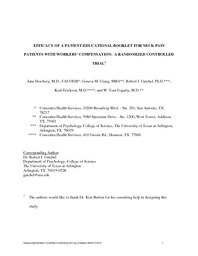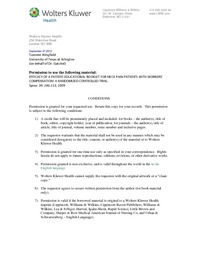| dc.contributor.author | Gatchel, Robert J. | |
| dc.contributor.author | Derebery, Jane | |
| dc.contributor.author | Giang, Geneva M. | |
| dc.contributor.author | Erickson, Kent | |
| dc.contributor.author | Fogarty, W. Tom | |
| dc.date.accessioned | 2010-09-08T13:25:18Z | |
| dc.date.available | 2010-09-08T13:25:18Z | |
| dc.date.issued | 2009-01-15 | |
| dc.identifier.citation | Published in Spine 34.2 (2009): 206-213 | en_US |
| dc.identifier.uri | http://hdl.handle.net/10106/5033 | |
| dc.description | Author's final draft after peer review, also known as a post print. | en_US |
| dc.description.abstract | Study Design. A randomized controlled trial of an educational booklet for patients with first-time neck pain.
Objective. To assess the clinical impact of a novel educational book on patients‟ functional outcomes and beliefs about neck pain.
Summary of Background Data. Previous research has shown that a novel education booklet (The Back Book) had a positive impact on low back pain patients‟ beliefs and clinical outcomes. The current study sought to evaluate the efficacy of a similar education booklet (The Neck Book) for neck pain patients.
Methods. Workers‟ compensation patients were given either the experimental booklet, a traditional booklet or no booklet. The primary outcome measures, collected at 2-weeks, 3-months, and 6-months after baseline, were The Fear Avoidance Beliefs Questionnaire (FABQ) and The Neck Pain & Disability Scale (NPDS). Health-related functional measures were also collected at these intervals.
Results. Only 34% (N=187) of an original cohort of patients (N=522) had data for all of the follow-up periods. For these 187 patients, repeated-measures analyses of covariance, using the baseline measure as the covariate, revealed no significant differences among the three groups on any of the outcome measures at any of the follow-up periods. For example, at 6-months, the experimental booklet, traditional booklet and no-booklet groups reported NPDS mean scores (SDs) of 31.3 (15.5), 35.3 (17.0) and 31.8 (15.6), respectively. Similarly, there were no significant effects for the FABQ scores—35.9 (21.5), 40.3 (22.1) and 38.0 (23.4), respectively.
Conclusions. This study demonstrates that the educational booklets studied were not associated with improved outcomes in patients with neck pain receiving workers‟ compensation. Whether
Manuscripts\booklet-NeckPain-EvalEfficacyR2-rjg-complete.806\6/2/2010 3
these results would apply to a non-workers‟ compensation population requires further study. The loss of many patients to follow-up also makes any other firm conclusions more difficult to determine. | en_US |
| dc.language.iso | en_US | en_US |
| dc.publisher | Lippincott Williams & Wilkins | en_US |
| dc.subject | Advice | en_US |
| dc.subject | neck pain | en_US |
| dc.subject | education booklet | en_US |
| dc.subject | randomized controlled trial | en_US |
| dc.title | Efficacy of a Patient-Educational Booklet for Neck Pain Patients with Workers' Compensation: A Randomized Controlled Trial | en_US |
| dc.type | Article | en_US |
| dc.publisher.department | Department of Psychology, The University of Texas at Arlington | en_US |
| dc.identifier.externalLink | http://www.uta.edu/ra/real/editprofile.php?pid=18&onlyview=1 | en_US |
| dc.identifier.externalLinkDescription | Link to Research Profiles | en_US |


